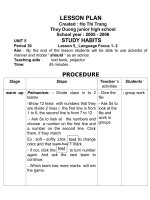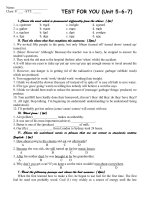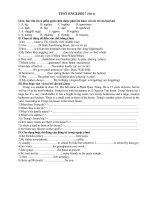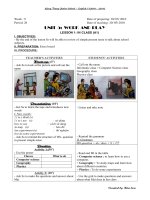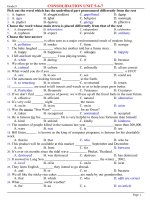- Trang chủ >>
- Đề thi >>
- Đề thi lớp 7
UNIT 5 English 7 New
Bạn đang xem bản rút gọn của tài liệu. Xem và tải ngay bản đầy đủ của tài liệu tại đây (159.35 KB, 19 trang )
Teacher’s name: Nguyen Van Dung
Week: 12 Period: 34
Date: 27/11/2017
UNIT 5: VIETNAMESE FOOD AND DRINK
Lesson 1: Getting started
I- Aims: Help SS know about food and drink in Viet Nam
II. Objectives: By the end of the lesson, Ss will be able to
- Understand the content of the dialogue. Ss ask and answer different traditional food.
- Develop listening and speaking skills
* Language Content:
- Vocab - The lexical items related to the topic “ Food and Drink”
- Grammar:
III. Teaching aids: Materials: Ss’ books, text books, tape recorder and CD…
IV- Techniques: T-SS, SS-SS,PW,GW
V. Procedure
Stages- Time –
Focus
1. Warm up:
5’ – T-SS
T’s activities
Ask Ss about the picture:
1- Where are Phong and his mum?
2- What might be happening to them?
3- What are they doing?
4- What is there in the fridge?
2- Activities
* Teaching new words:
- Elicit some new words (pictures, realia, situations ….)
- Have Ss read twice
* Checking vocab: matching
SS’ activities
Ss answer the questions
Copy new words in the notebook
Vocabulary:
- tofu(n):
- noodles (n):
- warm sth up ( v):
- mineral water (n):
- carton (n):
Practice
25’- T-SS
1. Play the recording. Sts listen and read.
Ss work and share their answers with friends.
T correct.
Have Ss work independently.
1. Listen &read:
a) Read the conversation and answer the
questions:
1. Because his parents are going to the opera
tonight and they won’t be home until 9 pm.
2. There’s some rice left from lunch.
3. Phong should warm it up.
4. She’ll buy some milk tomorrow.
5. He can have some orange juice instead of milk.
b) Find the word about Food and Drink.
Food
T. asks Ss not to look at the book and try to remember
which foods and drinks.
2. Have Ss quickly match each word/ phrase with its
picture.
3. Ask Ss to think about their favorite food and drink.
Ss work in pairs
Example:
A: What’s your favorite food?
B: It’s pho bo - beef noodle soup.
A: When do you usually eat it?
B: In the morning.
4. Ss listen and repeat the adjectives.
meat
tofu
fried vegetables
bread
noodles
rice
Drink
milk
Juice
mineral water
orange juice
2. Match the food and drink with the pictures.
1- J, 2 - F, 3 - A, 4- B, 5 - D, 6 - I, 7- G,
8 - H, 9- E, 10 - C.
3. Think about their favorite foods and drinks.
- Work in pair
Ss can add some more adjectives to talk about the food
and drink in 2.
Production
14’ – SS-SS
5. Ss work in groups. One student describes his favorite
food or drink. The rest of the group tries to guess which
food or drink it is.
- Be ready for a closer look 1.
- Learn by heart some words
4. Listen and repeat the adjectives.
1. bitter
5. salty
2. delicious
6. spicy
3. tasty
7. fragrant
4. sweet
8. sour
5. Game: What’s your favorite food and drink?
Example:
A: It’s my favorite drink. It’s a bit sour, but It’s
also sweet.
B: Is it lemonade?
A: Yes, it is / No, try again.
Homework
Take note
1’
Reflexive : ………………………………………………………………………..
…………………………………………………………………………………………………………………………………………
…………………………………….
Teacher’s name: Nguyen Van Dung
Week: 12 Period: 35
Date: 27/11/2017
UNIT 5: VIETNAMESE FOOD AND DRINK
Lesson 2: A Closer look 1
I- Aims: Help SS how to pronounce the sound / ɒ / and / ɔ: /
II. Objectives:
- By the end of the lesson, Ss will be able to use some verbs to make the pancake with some vegetables. Ss can practice
pronouncing / ɒ / and / ɔ: / fluently.
- Develop listening and speaking skills
* Language Content:
- Vocab: - The lexical items related to the topic “ Food and Drink”
- Grammar: Imperative
III. Teaching aids: Materials: Ss’ books, text books, tape recorder and CD…
IV- Techniques: T-SS, SS-SS, PW, GW
V. Procedure
Stages – Time
– Focus
Warm up:
5’- T-SS
Presentation
5’ –T-SS
Ss’ and T’s activities
- Play game: slap the board
- Uses some techniques to teach vocab
Checking: Rub out and remember:
Contents.
- Words about food and drink
- Take part in the game.
Vocabulary:
- heat (v):
- pour (v):
- fold (v)
- beat (v)
- serve (v)
- turmeric (n)
- pepper (n)
Practice
30’ – T-SS
1. Play the recording twice.
Ss repeat chorally and individually.
Ask SS to look at the pictures and complete the
instructions with the verbs in the box. Then, listen,
check and repeat the instructions
- Work individually.
1. Beat
2. Heat
3. Pour
4. Fold
5. Serve
2. Ask SS to do the exercise individually. Put the
words in the correct order to make sentences.
and then check with the whole class.
- Work individually
1. Beat the eggs together with sugar, flour , and milk.
2. Pour ¼ cup of the mixture into the pan at a time.
3. Heat the oil over a medium heat in a frying pan.
4. Cook until golden.
5. Serve the pancake with some vegetables.
3. Check Ss’ understanding of the meanings of the
nouns given.
Ss put the nouns in the correct columns.
Production
T-SS – 4’
4. T models the sounds / ɒ / and / ɔ: / first and let Ss
see how the sounds are formed.
Ask Ss to practice the sounds together.
5- Plays the recording
Ask SS to listen and circle the words they hear
- Do individually
Dishes
Ingredients
pancake, beef
salt, cooking oil,
noodle soup,
flour, pork,
spring rolls,
turmeric, pepper,
noodles, pork,
noodles.
omelette,
sandwich.
4. Listen and repeat the words. Pay attention to the
sounds / ɒ / and / ɔ: /.
Answer:
- / ɒ /: soft, hot, bottle, pot, rod.
- / ɔ: /: pork, salt, fork, sport, sauce.
5. Listen to the sentences and circle the correct words
you hear.
1. cod
2. port
3. sports
4. fox
5. short
Homework:
1’
Prepare for next.
Learn by heart some words
- Take notes
Reflexive: ………………………………………………………………………………………………………………………
Teacher’s name: Nguyen Van Dung
Week: 12 Period: 36
Date: 27/11/2017
UNIT 5: VIETNAMESE FOOD AND DRINK
Lesson 3: A Closer look 2
I- Aims: Teach SS about the countable / uncountable noun and how to make question with How much / many
II. Objectives:
- By the end of the lesson, Ss will be able to use How much and How many to ask about quantity.
- Distinguish countable nouns and uncountable nouns.
*Language Content:
- Vocab: - The lexical items related to the topic “ Food and Drink”
- Grammar: Nouns (countable nouns and uncountable nouns)
- How much and How many?
- a/ an/ some/ any
III. Teaching aids: Materials: Ss’ books, text books, tape recorder and CD…
IV- Techniques: T-SS, SS-SS, PW, GW
V. Procedures
Stage – Time
– Focus
Warm up:
5’ – T-SS
Presentation
5’/ T-SS
T’s activities
- Brainstorming:
Two Ss go to the board and write the adjs about food
and drink they’ve learnt. (in 5 minutes).
The person who writes more words is winner.
T asks Ss to study the Grammar Box. Draw Ss’
attention to the difference between countable nouns
and uncountable nouns.
Ss give some more examples.
SS’ activities
Take part in the game.
I. Grammar:
For uncountable nouns we can use phrases like a bottle
of, a piece of, a bar of, a glass of , a kilo of, a bag of, a
lot of…
1. Which of the following nouns are countable and
Practice
25-/ T-SS/ SSSS
1. Ask Ss to do the grammar exercise individually.
Remind them to refer to the Grammar Box.
- Ask Ss to study the Grammar Box. Draw Ss’
attention to the use of a, an, some and any by
analyzing the instructions and examples in the
Grammar Box.
2. Demonstrate the game to the class first. Then
when Ss know exactly what to do. Ask them to work
in groups.
3Ask SS to complete the conversation with: a/ an /
some / any. Ss work individually.
which are uncountable?
Key:
Countable: banana, apple
Uncountable: bread, beef, pepper, pork, turmeric,
spinach.
Countable nouns:
Singular:
Plural
There is an egg.
There are some eggs.
Uncountable nouns:
There is some milk
There isn’t any milk
Is there any milk?
Note : We can use Some in an offer or a request.
Example: Would you like some bananas?
Can I have some milk, please?
2. Game: Give me an egg!
One team says words related to food or drink.
The other team add s some /a/ an.
Example:
Team 1: egg
Team 2: an egg
3. Fill the blanks with a/ an / some or any in the
following conversation.
1. any
2. some
3. some
4. any
5. a
6. an
4. Fill each blank with How many or How much.
Production
9’/ T-SS
4. Ask Ss to study the Grammar Box.
How many + ( countable noun) Ns
How much + (uncountable noun) N
1. How many
2. How much
3. How many
4. How many
5. How much
5. Ask Ss to perform.
5. Use the suggested words to make questions with
How much/ How many, the interview your partner.
Example:
How much milk do you drink every morning?
- Take notes
Homework:
1’
Be ready for Communication
Learn by heart some words and grammar.
Reflexive: ……………………………………………………………………………………………………………………………..
Teacher’s name: Nguyen Van Dung
Week: 13 Period: 37
Date: 1/12/2017
UNIT 5: VIETNAMESE FOOD AND DRINK
Lesson 4: Communication
I- Aims: Help SS talk about their favorite food and drink
II. Objectives: By the end of the lesson, Ss will be able to:
- Talk about different types of Vietnamese food, drink and recipes.
- Develop listening and speaking skills
* Language Content:
- Vocab: - The lexical items related to the topic “ Food and Drink”
III. Teaching aids: Materials: Ss’ books, text books, tape recorder and disk…
IV- Techniques: T-SS, SS-SS, PW, GW, Indi
V. Procedure
Stage – Time –
Focus
Warm up:
5’ / T-SS
Presentation
T-SS / 5’
T’s activities
Chatting: ask and answer some questions about food
and drink..
- Elicit some new words through translation and
situations.
Have Ss understand the meaning of the words.
Ss predict.
Read aloud 3 times and then have students read
individually.
* Checking vocab: Rub- out and remember.
SS’ activities
- Talk about their food and drink
Vocabulary:
- sticky rice: (n)
- sauce: (n)
- sausage: (n)
- yoghurt: (n)
- tuna: (n)
- ham : (n)
- Copy new words in notebook
Practice
25’ / SS-SS
Production
9’ / SS-SS
- Play the recording ask Ss to listen and check
their predictions.
1. Listen to a celebrity chef, Austin Nguyen talking
about his favorite food. Which food in Extra
vocabulary does he talk about?
- First, have Ss read the questions in the table
carefully and ask them to note their answers. Then
ask Ss to share their answers in pairs to find out what
they have in common their partners.
- Check some pairs.
2. What are your favorite foods and drinks? Write
your answers in the table below.
Example:
My favorite food is spring roll.
It tastes delicious.
….
3. Interview three students about their favorite
- Ask Ss to move around and ask different classmates foods and drinks.
every question.
- T calls on some Ss to report the results of the ir
interviews before the whole class.
Homework:
1’
4. Report your results to the class.
3. Homework:
Prepare for Skills 1
Learn by heart some new words.
Reflexive: ………………………………………………………………………..………………………………………………….
Teacher’s name: Nguyen Van Dung
Week: 13 Period: 38
Date: 1/12/2017
UNIT 5: VIETNAMESE FOOD AND DRINK
Lesson 5: Skills 1
I. Aims: Help SS practice Reading skill and learn how to make an omelette
II.
Objectives: By the end of the lesson, Ss will be able to:
- Make a bowl of noodles “ Pho” and omelette.
- Read for specific information about Pho, a popular food in Viet Nam.
- Develop reading and speaking skills.
*Language Content:
- Vocab: - The lexical items related to the topic “ Food and Drink”
- Review : a/ an / some /any...
III- Teaching aids: Materials: Studentbooks, teacherbook, projector, pictures…
IV- Techniques: PW, GW, Indi….
V. Procedures:
Stage – Time –
Focus
Warm up
5’ / T-SS
Presentation
5’ / T-SS
T’s activities
T asks Ss to look at the picture of a bowl of Pho.
Ask them:
- What dish do you think it is?
- Which place is famous for this dish?
- What are the ingredients for it?
- When do people often have it?
- Do you like to have it? Why or Why not?
- T uses some techniques to present new words
SS’ activities
Ss give the answers.
I.
New words:
stew (v) (picture) :
bone (n) (pic)
broth (n) :
Check understanding: Rub-out and remember.
Practice
24’ / T-SS
SS-SS
- Ask Ss to scan the passage to answer the questions.
- T gives the feedback.
- T asks Ss to note where they found the information
that help them to answer the questions.
- Ss can compare answers before discussing them as a
class.
- T gives the key and Ss check.
- T reminds Ss of the form and use of a/an/ some
/any…
- Ss work in pairs, asking and answering questions
about the ingredients for an omelette.
Production
10’ / T-SS
boneless (adj)
teaspoon (n) (pic)
pinch (n)
ingredient (n)
*Reading:
Exercise 2. Read Phong’s blog again and answer
the questions.
1. We can enjoy pho all kinds of meals during a
day, from breakfast to dinner and even for a late
night snack.
2. They are made from the best variety of rice.
3. The broth for pho bo is made by stewing the
bones of cows for a long time in a large pot. The
broth for pho ga is made by stewing chicken
bones.
4. It is boneless and cut into thin slices.
* Speaking:
Exercise 3. Look at the list of ingredients below.
Work in pairs. Ask and answer questions about
the ingredients for an omelette.
Example:
A: I want to cook an omelette. What ingredients do
I need?
B: You need….
A: How much/ How many?.....
T asks Ss to work individually, using the phrases in the 4. Look at the picture of how to cook an
box to complete the instructions on how to cook an
omelette.
omelette.
Example:
1. d
2. e
3. a
4. b
5. c
5. Work in pairs. Practicing giving instructions
on how to make a dish or drink.
Homework
1’
- Learn by heart new words.
- Do ex. D1,2,3 ( workbook)
- Prepare for the next.
Reflexive: ………………………………………………………………………..
…………………………………………………………………………………………………………………………………………
Teacher’s name: Nguyen Van Dung
Week: 15
Date: 1/12/2017
Period: 39
UNIT 5: VIETNAMESE FOOD AND DRINK
Lesson 6: Skills 2
I. Aims: Help SS practice Listening and Writing skills
II. Objectives: By the end of the lesson, Ss will be able to:
- Listen for specific information about different traditional food.
- Write about some popular foods or drinks.
- Develop listening and writing skills.
* Language Content:
- Vocab: - The lexical items related to the topic “ Food and Drink”
III- Teaching aid: Materials: Student books, teacher book, projector, pictures…
IV- Techniques: T-SS, SS-SS, PW, GW, Indi
V. Procedures:
Stage- Time
– Focus
Warm up
5’ / T-SS
T’s activities
SS’ activites
- T invites two groups of 5 students to take part in the
game and gives some rules of the game.
T Take part in the game: Chain game:
Eg: drink……..
Presentation
5’ / T-SS
- T uses some techniques to present some new words.
I. New words:
eel (n)
turmeric (n)
shrimp (n)
Practice:
25’ / T-SS
SS-SS
- T asks Ss to read the instructions carefully and
remind them to remember the name of three places
and three dishes mentioned in the conversation they
are going to listen.
T plays the recording.
* Listening
1. Listen to three people talking about traditional
dishes where they live. Match the places with
the dishes.
Key:
1. b
- T asks Ss to read the rubric and study the table
carefully.
2. a
3. c
2. Listen again. Tick the ingredients for each dish.
Some ingredients are in more than one dish.
Key:
banh tom : shrimp
Ss read the rubic and study the map carefully.
sup luon : eel, pepper, turmeric,
T calls on some Ss to write their answers on the board. my quang : rice noodles, shrimp, pork
* Writing
3. Make notes about some popular foods or drinks
4- T asks Ss to make notes about some popular foods
in your neighbourhood.
or drinks where they live.
Ss do not have to write full sentences and they can use
abbreviations.
Production
9’- T-SS
Homework
1’
4. Post-tasks
- Set up the writing activity.
- Ss write a draft first. Then have them write their final
version in class or at home.
4. Write a paragraph about popular foods or
drinks in your neighborhood. Choose one or more.
Use the information in 3, and Phong’s blog , as a
model.
- Complete the writing tasks into your notebook.
- Do exercise E 1, 2 ( workbook )
- Prepare for the next.
Reflexive: …………………………………………………………………………………..…………………………………….
Teacher’s name: Nguyen Van Dung
Week: 14 Period: 40
Date: 5/12/2017
UNIT 5: VIETNAMESE FOOD AND DRINK
Lesson 7: Looking back + Project
I- Aims: Help SS review what they learned in unit 5
II. Objectives: By the end of the lesson, Ss will be able to
- Cover the whole unit and do exercises.
- Know some ways of using “ a/ an / some and any…”.
- Communication.
*Language Content:
- Vocab: - The lexical items related to the topic “ Food and Drink”
- Grammar: Nouns (countable nouns and uncountable nouns)
How much and How many?
a/ an/ some/ any
III. Teaching aids: - CD player, CD
IV- Techniques: T-SS, SS-SS, PW, GW, Indi
V. Procedures:
Stage – Time T’s activities
SS’ activities
Focus
Warm up
1. Warm-up
5’ / -T-SS
T calls on some Ss to go to the board and add the
1. Add the words or phrases they have learnt
words or phrases they have learnt to the column.
to the column.
Key:
Dishes: omelette, pancake, beef noodle soup,
chicken noodle soup, rice, noodle pork,
sandwich, meat, tofu, bread, spring roll…
Ingredients: shrimp, salt, cooking oil, flour,
Pork, turmeric, pepper, noodle, vegetable, egg,
meat, tofu…
Phrases: a slice, a can, a bottle, a kilo, a bar, a
glass, a bag, a teaspoon, a tablespoon…
Practice:
1. Ss read the sentences carefully, and complete them
with the verbs from the box.
2. Fill each gap with a verb from the box.
1. Fold
2. Pour
3. Beat
4. Heat
5. Serve
2. Grammatical exercises.
T asks Ss to work individually first.
3. Ss do exercise 3.
4. Ss do exercise 4, 5
T asks Ss to go to the board and write.
5. T asks Ss to role-play in pairs.
Exercise 3. Choose a/ an or some for the
following words.
Key:
1. a
2. some
3. some
4. some
5. some 5. some
6. some
7. an
8. some
Exercise 4. Complete the sentences with some
or any.
1. any
2. some
3. any
4. some/ any
5. any/ some
Exercise 5. Make questions with How many/
How much for the underlined words in the
following sentences.
2. How much milk is there in the bottle?
3. How many cans of lemonade do you need?
4. How many apples does Peter got in his bag?
5. How much rice is there left in the electric
cooker?
6. Choose sentences (A - D) to complete the
following conversation. Practice the
conversation with a partner.
Key:
1. D
2. B
3. A
4. C
7. Role-play the questions and answers.
Production
T-SS / 9’
Homework
1’
- Do the Project
- Prepare for the next.
- Take note
Reflexive: …………………………………………………………………………………………………………………………….

